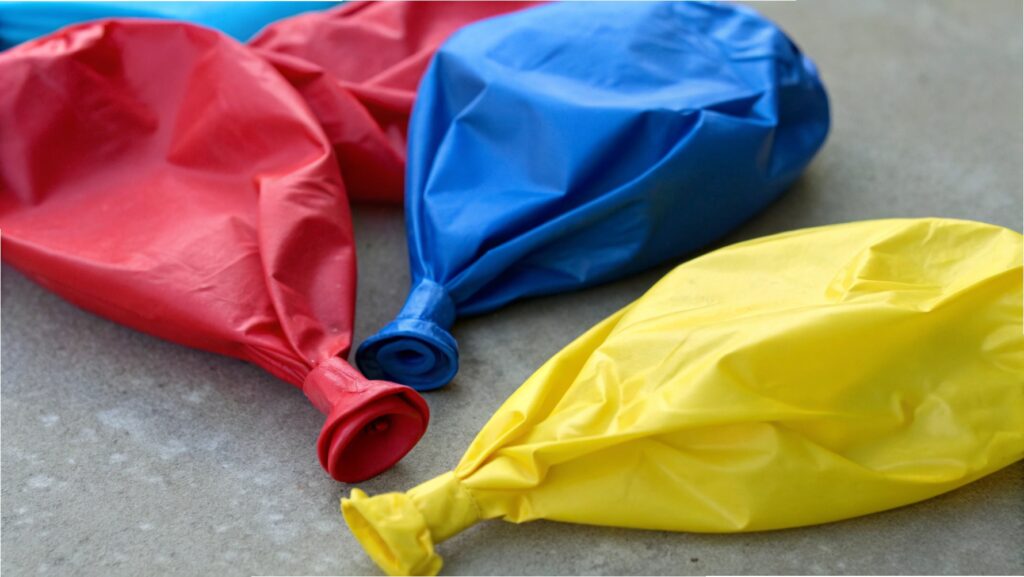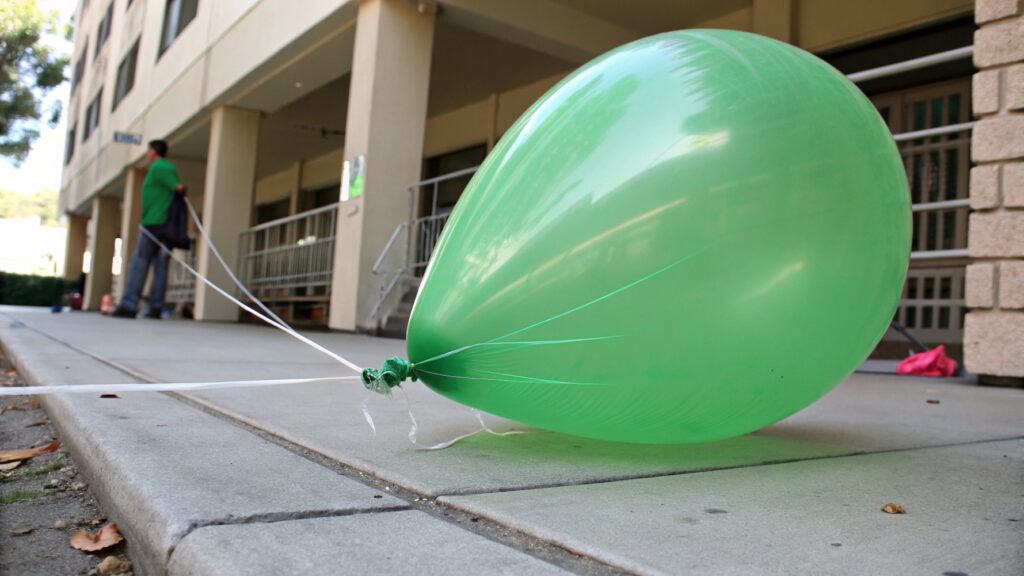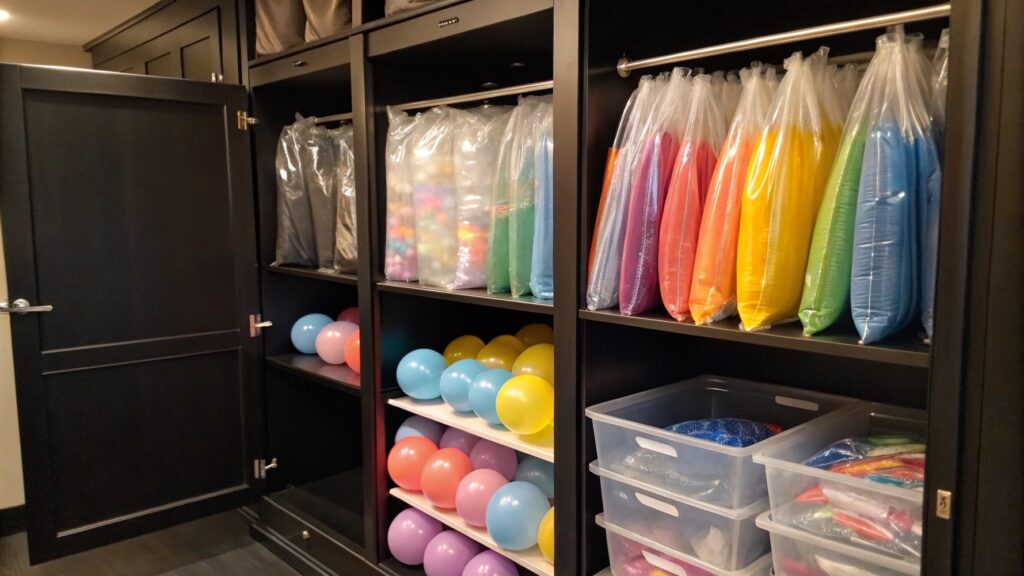Why do latex balloons wrinkle?
Have you ever noticed your beautiful latex balloons looking a little less perky, covered in unsightly wrinkles? This frustrating issue can ruin the aesthetic of any event.
Latex balloons wrinkle1 because the material contracts unevenly2 as air or helium slowly leaks out. When a balloon deflates, the stretched rubber relaxes3, often in a non-uniform way4, causing creases and folds on its surface.

Understanding why balloons wrinkle can help you keep them looking their best for longer. Let's look at some key factors that cause this common problem.
Are latex balloons prone to wrinkling with age?
Does the lifespan of a latex balloon truly contribute to its wrinkled appearance over time? It's a common observation that older balloons5 often look far less pristine.
Yes, latex balloons are prone to wrinkling with age as they naturally deflate. Over time, the gas inside6 (air or helium) slowly escapes through the porous latex material7, causing the balloon to lose volume and the material to contract and wrinkle.

When I first started in the balloon industry, I focused a lot on fresh manufacturing. But I quickly learned that even the best new balloons would wrinkle if left for too long. This happens because latex is a natural material, and it is semi-porous. This means tiny amounts of gas can escape over time. Think of it like a tire slowly losing air Pressure. As the gas escapes, the balloon gets smaller. The latex material, which was stretched smoothly when full, starts to fold back on itself. This folding is not always even, so it creates wrinkles and creases. The longer the balloon stays inflated, the more gas escapes, and the more pronounced the wrinkles become. This process also happens faster in certain conditions. For example, if the balloon is exposed to heat or direct sunlight, the latex can degrade more quickly, and the gas can escape faster. This speeds up the wrinkling process.
| Factor | Impact on Wrinkling | Explanation |
|---|---|---|
| Material Age | High | As latex ages, its elasticity can decrease. This makes it less able to return to a smooth state during deflation. Old latex also becomes more permeable, meaning gas escapes faster. Faster gas escape leads to quicker and more significant wrinkling. |
| Gas Permeation | High | Latex is a porous material. Air and helium molecules slowly pass through the balloon wall over time. This continuous loss of gas causes the balloon to deflate gradually. As the balloon deflates, the stretched latex material contracts unevenly2, resulting in wrinkles. This is a natural process that cannot be entirely stopped, but it can be slowed down. The rate of gas permeation depends on the quality of the latex and environmental conditions. Higher quality latex generally has tighter molecular structures, which slow down the permeation. |
| Storage Time | High | The longer a balloon is stored, even uninflated, the more its material can relax or degrade slightly. Once inflated, its ability to hold shape might be compromised. Storage in direct sunlight or extreme temperatures speeds up material degradation, making the balloon more prone to wrinkling when it eventually deflates. Proper storage conditions, like cool and dark places, help preserve the latex quality. When a balloon is stored poorly, the latex can become brittle or less elastic. This means it will not stretch as smoothly when inflated. |
| Inflation Duration | High | The longer a balloon remains inflated, the more time gas has to escape, and the more opportunity the latex has to begin its wrinkling process. Continuous tension on the latex for extended periods can also make it less elastic. This can cause more pronounced wrinkles when it finally contracts. Even tiny leaks, which are normal, add up over hours and days. The longer the balloon stays up, the more deflation occurs. With more deflation, the rubber contracts more, and wrinkles become more visible. It is a slow, ongoing process. |
| External Factors | Medium | Exposure to extreme temperatures, direct sunlight, or strong air currents can accelerate the aging process of latex. These conditions can cause the latex to dry out or degrade faster, increasing the rate of gas escape and subsequent wrinkling. For example, a balloon left in a hot car will deflate and wrinkle much faster than one kept indoors. The heat causes the latex to expand and contract more rapidly. This puts stress on the material. This stress makes it easier for gas to escape. It also causes the latex to lose its elasticity more quickly. |
Does over-inflation8 cause wrinkles in latex balloons?
Is it true that pushing a latex balloon past its recommended size can lead to unsightly wrinkles when it eventually deflates? Many people wonder about this common issue.
No, over-inflation itself does not directly cause wrinkles. Instead, over-inflation can weaken the latex. This makes the balloon more prone to bursting or deflating rapidly. When a balloon deflates too quickly, the material contracts abruptly and unevenly, which then results in wrinkles.

When I train new staff at AIHUA BALLOON, I always stress the importance of proper inflation9. It's a fine line between a perfectly round balloon and one under too much stress. Over-inflating a balloon stretches the latex very thin. This extreme stretching puts a lot of stress on the material. While it does not directly cause wrinkles at that moment, it does make the balloon more vulnerable. The over-stretched latex is more likely to lose air faster because the pores become larger. If the balloon then deflates very quickly, the material shrinks back without enough time to settle smoothly. This rapid and uneven contraction is what forms the wrinkles. It's less about the inflation itself and more about the consequences of over-stressing the material. This can lead to a sudden loss of air. We always recommend inflating to the suggested size to ensure the balloon looks good and lasts longer.
| Factors | Impact on Wrinkling | Explanation |
|---|---|---|
| Material Thinning | High | Over-inflating stretches the latex far beyond its optimal elasticity. This makes the material much thinner than it should be. Thin latex is weaker and more permeable. It lets gas escape at a faster rate. As the gas escapes rapidly, the balloon deflates quickly. When the material deflates fast, it contracts unevenly, leading to wrinkles. The thinness means the latex cannot hold its smooth shape as it shrinks. Instead, it forms creases because of the quick loss of internal pressure. This happens because the overstretched bonds in the latex cannot spring back smoothly. |
| Increased Permeability | High | When latex is over-inflated, its molecular structure becomes more stretched and sparse. This increases the porosity of the material. Increased porosity means that air or helium molecules can pass through the balloon wall more easily and quickly. This rapid escape of gas causes the balloon to deflate much faster than normal. The faster the deflation, the more sudden and uneven the contraction of the latex. This sudden contraction creates more wrinkles. High-quality latex is designed to have a less porous structure. However, even top-quality latex can become too permeable if over-inflated. |
| Stress on Seams | Medium | Over-inflation puts extreme stress on the seams and neck of the balloon. These areas are already points of weakness. Excessive pressure can cause microscopic tears or weaken the seal. This leads to faster air leakage from these specific points. Uneven leakage can cause parts of the balloon to deflate faster than others. This causes the rubber to contract unevenly. This uneven contraction then results in localized wrinkles and creases, often starting from the stressed areas. This is why a balloon might wrinkle around the neck first. The stress on the seams can also cause the balloon to burst sooner. |
| Reduced Elasticity | Medium | Consistently over-inflating a balloon over its lifetime, or even just during one inflation, can permanently reduce the latex’s elasticity. Much like a stretched-out rubber band, over-stressed latex may lose its ability to return to its original smooth state. When it finally deflates, it retains some of the stretched, distorted shape, which appears as wrinkles. This loss of elasticity compounds the problem from rapid deflation, making the wrinkles more pronounced and less likely to smooth out. The material simply cannot retract as smoothly as it should. It is like an old piece of clothing that has lost its stretch. |
| Burst Risk | High | While not a direct cause of wrinkles, over-inflation significantly increases the risk of the balloon bursting. A burst balloon means an immediate end to its intended use. If a balloon bursts, there are no wrinkles, just torn pieces. However, if a balloon is at the brink of bursting due to over-inflation, it is extremely prone to sudden, rapid deflation. If it does not burst but rapidly deflates from a significant leak due to over-stretching, the quick loss of volume causes severe wrinkling. This is because the stressed material cannot retract smoothly when the sudden pressure drop happens. |
Can humidity levels affect wrinkling in latex balloons?
Does the amount of moisture in the air play a role in how latex balloons wrinkle? It's a detail often overlooked but could be crucial.
Yes, humidity levels can affect wrinkling in latex balloons. High humidity can cause latex to absorb moisture, making it heavier and less buoyant. It can also accelerate the degradation of the latex. This leads to faster air permeation and uneven deflation, resulting in more pronounced wrinkles.

This is one aspect I always discuss with our R&D team at AIHUA BALLOON. We have observed that balloons behave differently in various climates. In very humid environments, the latex material can absorb some moisture from the air. This makes the balloon slightly heavier, and it can also affect its structural integrity over time. A moist latex surface might also become stickier, making the folds and creases stick together when the balloon deflates, thus creating more visible wrinkles. Conversely, in very dry conditions, the latex can dry out and become brittle, which also impacts its elasticity and can lead to cracking or small tears that cause faster air loss and wrinkling. Neither extreme is ideal. We design our balloons to be resilient, but environmental factors always play a part in their lifespan.
| Factor | Impact on Wrinkling | Explanation |
|---|---|---|
| Moisture Absorption | High | In high humidity, latex can absorb a small amount of moisture. This makes the balloon slightly softer and heavier. While not directly causing wrinkles, moisture can affect the latex's elasticity and overall stability. If the latex absorbs moisture, it changes its properties slightly. This can make it less able to smoothly contract when deflating. The increased water content can also create a less uniform surface, which is more prone to uneven folding. This uneven folding leads to wrinkles. Think of a sponge that is wet versus dry. A wet sponge folds differently. |
| Accelerated Degradation | High | High humidity, especially when combined with high temperatures, can accelerate the degradation of natural latex. This means the material breaks down faster. As the latex degrades, its molecular structure weakens, and its pores become larger. This directly leads to faster gas permeation. When gas escapes more quickly, the balloon deflates rapidly. This rapid, uneven deflation causes more prominent wrinkles. The faster the material loses its integrity, the less capable it is of maintaining a smooth surface. This accelerated degradation is a key reason why balloons deflate and wrinkle faster in humid environments. |
| Brittleness in Low Humidity | Medium | Conversely, very low humidity can cause latex to dry out. When latex becomes too dry, it loses its natural elasticity and becomes brittle. This brittleness makes the material more rigid and less flexible. If a dry, brittle balloon deflates, it will not contract smoothly. Instead, it might crack or crease sharply, leading to more pronounced and rigid wrinkles. Additionally, dryness can sometimes cause microscopic cracks in the latex surface, which allows for faster gas leakage and contributes to more rapid deflation and wrinkling. It is like dry skin that cracks more easily. |
| Surface Stickiness | Low | In very high humidity, the surface of latex balloons can become slightly sticky. While this does not directly cause wrinkling from deflation, it can make existing wrinkles more noticeable or permanent. If the deflating material folds in on itself when the surface is sticky, the folds might adhere to each other. This prevents the latex from smoothing out fully. This makes the creases more prominent. This effect is more about making wrinkles visible rather than creating them from the initial deflation process. However, it is an exacerbating factor once wrinkles begin to form. |
| Mold and Mildew | Low | In extremely high and prolonged humidity, there is a risk of mold or mildew growing on natural latex. While not a direct cause of wrinkling, mold can degrade the latex material. This degradation can lead to weakening of the balloon structure. A weakened structure can lose gas faster. If this happens, it can contribute to uneven deflation and subsequent wrinkling. This is a less common issue purely for wrinkling, but it points to the overall negative impact of very high humidity on latex. It affects the material's integrity over time. |
What's the best way to store latex balloons to prevent wrinkles?
Is there a secret method to storing latex balloons that keeps them pristine and wrinkle-free until needed? Storage can make a huge difference in their ready-to-use quality.
The best way to store latex balloons to prevent wrinkles is to keep them uninflated in a cool, dark, dry place, away from direct sunlight, extreme temperatures, and sharp objects. This preserves the latex and its elasticity until inflation.

At AIHUA BALLOON, we emphasize proper storage to buyers like Sarah Chen. Our 37 years of experience have shown that even a perfect balloon can be ruined by poor storage. When balloons are made, they come in tightly sealed bags. Keeping them in these original packages is the first step. This protects them from air and light. I always tell our customers to think of balloons like sensitive food items—they need a cool, dry pantry, not a sunny windowsill. Heat and light are enemies of latex. They break down the material over time, making it less elastic and more prone to wrinkling even before inflation. Proper storage ensures the latex stays fresh and supple. This allows it to inflate smoothly and deflate evenly when the time comes. This minimizes wrinkles.
| Storage Method | Impact on Wrinkling Prevention | Explanation |
|---|---|---|
| Cool, Dark Place | High | Storing uninflated latex balloons in a cool, dark environment is crucial. Heat and direct sunlight are major culprits in degrading latex. They cause the material to break down prematurely. This makes it less elastic and more prone to cracking or uneven contraction when inflated and deflated. A dark place prevents UV light exposure, which can also weaken the latex. Think of a pantry or a closet. This helps maintain the latex's elasticity and structural integrity. A stable, cool temperature prevents the latex from undergoing rapid expansion and contraction. This keeps the material stable. This stability means the balloon will inflate smoothly and deflate more uniformly. |
| Airtight Packaging | High | Keeping uninflated balloons in their original airtight packaging or in sealed plastic bags is highly effective. This protects them from exposure to air, dust, and humidity. Air, especially oxygen, can cause the latex to oxidize and degrade over time. Dust can settle on the surface. When the balloon inflates, dust can create weak spots. Humidity can introduce moisture. An airtight seal minimizes these environmental exposures. This preserves the elasticity and lifespan of the latex. This packaging also helps prevent the balloon material from drying out too quickly, or absorbing too much moisture. Both can lead to problems during inflation and deflation. It effectively creates a micro-environment that shields the latex. |
| Away from Sharp Objects | High | While not directly preventing wrinkles, storing balloons away from sharp objects is essential to prevent punctures or tears. Even a tiny, undetected hole can lead to rapid and uneven deflation. This rapid deflation is a primary cause of wrinkles. A balloon with a pinprick will deflate quickly from that spot. This makes the surrounding material contract unevenly. This creates a localized wrinkle. Ensuring a damage-free envelope means the balloon deflates uniformly when its time comes. This reduces the chances of irregular contraction. This is a basic but critical step for overall balloon integrity. Any damage means the balloon will not hold its shape. If it does not hold its shape, it will wrinkle. |
| Avoid Extreme Temperatures | High | Fluctuations between extreme hot and old temperatures are damaging to latex. High heat can cause the latex to become soft and sticky, accelerating degradation and causing it to lose its flexibility. Cold temperatures can make the latex brittle and rigid, leading to cracks or stiffness when handled. Both extremes compromise the material's elasticity. When latex loses elasticity, it cannot stretch and contract smoothly. This leads to more prominent wrinkling upon deflation. A stable temperature environment ensures the latex remains supple and responsive. This allows for smooth inflation and even deflation. It helps the balloon last longer. |
| No Direct Sunlight | High | Direct sunlight, especially UV light, is a major enemy of latex. UV rays break down the natural polymers in the latex. This causes the material to weaken, become discolored, and lose its elasticity more quickly. Exposure to sunlight significantly shortens the balloon's lifespan and increases its susceptibility to wrinkles, even before it is inflated. The damaged latex will not stretch as evenly when inflated. It will also deflate more rapidly and unevenly. This process leads to more severe wrinkling. Keep balloons away from windows or outdoor storage spots where they might get direct sun. This prevents premature aging. |
Conclusion
Latex balloons wrinkle mainly due to uneven deflation as the material contracts. Factors like age, over-inflation leading to rapid deflation, and humidity levels all contribute to this frustrating issue. Storing balloons properly in a cool, dark, dry place helps keep them smooth and colorful for your events.
-
Explore this resource to understand the science behind latex balloon wrinkling and how to prevent it. ↩
-
Learn how uneven contraction impacts the appearance and longevity of latex balloons. ↩ ↩
-
Find out why stretched rubber relaxes and how it contributes to balloon wrinkling. ↩
-
Understand the concept of non-uniform contraction and its role in balloon wrinkling. ↩
-
Explore the reasons behind the aging of latex balloons and their visual deterioration. ↩
-
Learn about the role of gas in the longevity and appearance of latex balloons. ↩
-
Discover how the porosity of latex affects gas retention and balloon quality. ↩
-
Find out the relationship between over-inflation and balloon wrinkling. ↩
-
Understand why proper inflation is crucial for maintaining balloon appearance and longevity. ↩
